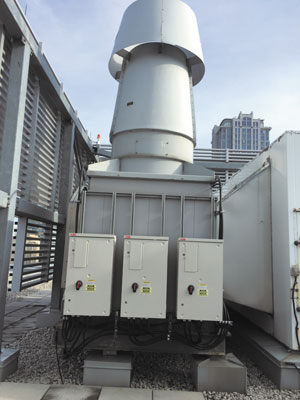
Products
University Health Network Adds Aircuity in Additional Building, Implements Exhaust Fan Control
Aircuity (www.aircuity.com), creator of measurably better environments, announces the expansion of its platform at University Health Network (UHN), the largest research hospital in Canada. Aircuity was chosen for its accurate intelligent building platform in order to reduce energy costs and improve the indoor environment.
Aircuity monitors the indoor environmental quality of buildings and informs building ventilation controls to provide optimal airflow levels. At UHN, Aircuity was first installed in the Princess Margaret Cancer Research Tower (PMCRT). The platform’s DCV control of the labs’ supply air saved approximately $800,000.

A powerful compliment to Aircuity’s platform in lab buildings is the exhaust fan application, but the previous exhaust system had produced a continuous discharge plume wasting energy when the air exhausted was clean. Aircuity and channel partner AirGenuity implemented Aircuity’s exhaust fan application for maximum savings within the building.
Newly installed variable frequency drives allowed fan speeds to be ramped up or down according to building needs. When Aircuity detects any contamination in the exhaust plenum, fan speeds are increased until the air is clean again. This intelligent platform ensures not only energy savings but also a clean, healthy space for researchers and occupants of surrounding buildings in downtown Toronto.
While the exhaust fan application was being installed at PMCRT, University Health Network installed Aircuity to optimize supply and exhaust air in its Krembil Research Tower, incurring additional savings. Once Aircuity’s exhaust fan application was implemented, annual savings amounted to 1,550,000 kWh (equivalent to 160 houses in Ontario) and electric peak demand savings of 111.7 kW (equivalent to running 1,400 flat screen TVs simultaneously). This saved $200,000 annually. Coupled with savings from the previous Aircuity lab project in PMCRT, utility cost savings total $1,000,000 annually.
“We wanted to create the best research spaces possible but in an environmentally and fiscally responsible manner,” said Ian McDermott, Senior Director, Research Facilities, UHN. “We looked for innovative solutions and partnering with AirGenuity/Aircuity was absolutely the right choice.”
About Aircuity
Aircuity creates smart airside solutions through its intelligent building platform, significantly reducing energy costs and improving the indoor environmental quality for occupants. As the leading demand control solution, Aircuity optimizes ventilation rates through its patented technology. As a result, commercial, institutional and lab building owners can lower operating costs, protect occupants and verifiably reduce energy use by as much as 60 percent. Founded in 2000 and headquartered in Newton, MA, Aircuity’s solutions have benefited over 400 organizations such as Google, Amazon, Eli Lilly, Masdar City, the University of Pennsylvania, and the University of California-Irvine. For additional information on the company and its solutions, please visit: www.aircuity.com.













